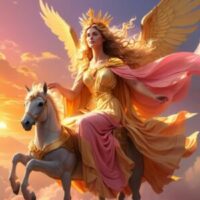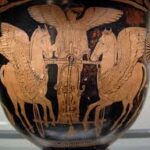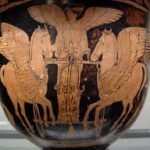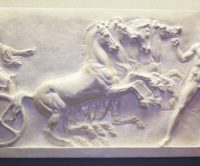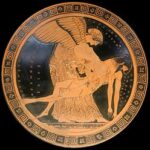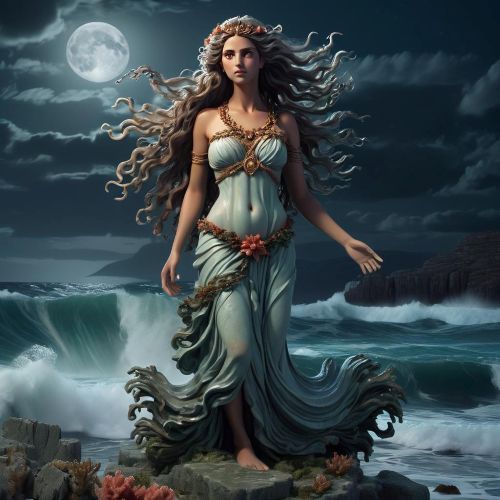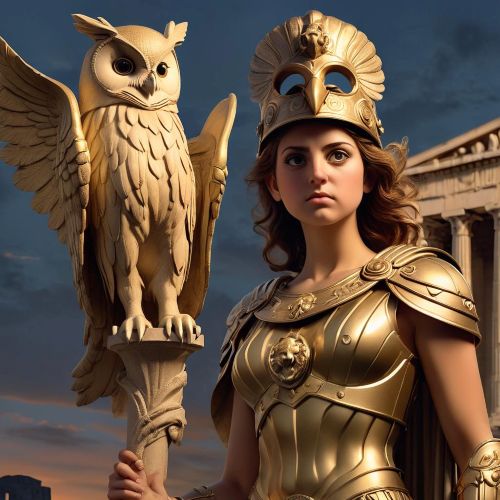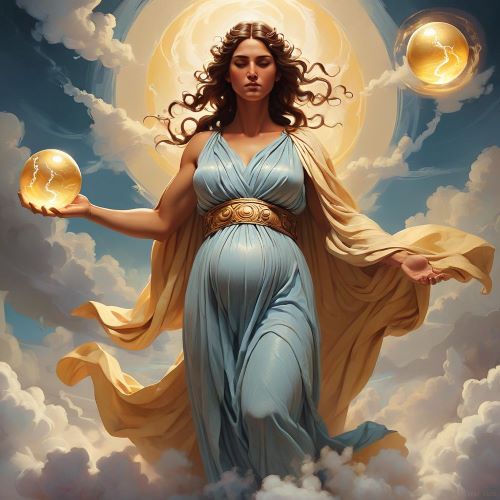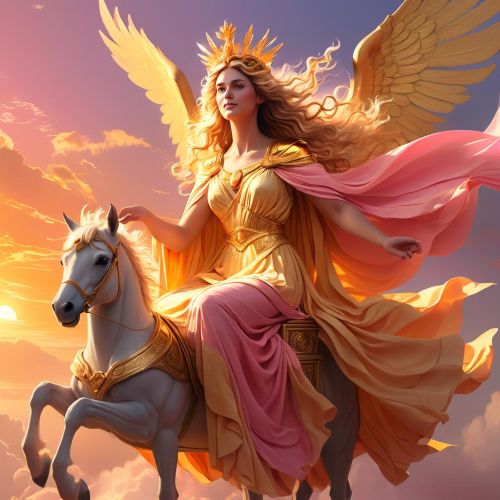
Eos : Goddess of the Dawn
Listen
At a glance
| Description | |
|---|---|
| Origin | Greek Mythology |
| Classification | Gods |
| Family Members | Hyperion (Father), Theia (Mother), Helios (Brother), Selene (Sister), Astraeus (Husband) |
| Region | Greece |
| Associated With | Light, Dawn |
Eos
Introduction
In Greek mythology, Eos is the awe-inspiring goddess of the dawn, who opens the gates of heaven every morning to welcome the sun. As the sister of Helios, the sun god, and Selene, the moon goddess, Eos plays a vital role in the celestial cycle, ushering in each new day. Her presence symbolizes renewal, beauty, and the hope that comes with fresh beginnings. Revered for her grace and divine responsibilities, Eos stands as a key figure not only in myth but also in the way ancient Greeks conceptualized time and nature.
Physical Traits
Eos is frequently envisioned as a figure of radiant beauty. With skin that glows like the first light of morning and hair cascading in hues of gold and rose, she perfectly embodies the visual essence of dawn. Artists often depict her with large white or golden wings, showing her swift travel across the sky. Dressed in robes of saffron or soft pink, she may be seen scattering flowers or dew, adding a sense of freshness and life to her surroundings. The horses pulling her chariot, typically named Lampus (“Shining”) and Phaethon (“Blazing”), emphasize her connection to light and motion. These visual cues allow her to be instantly recognizable across various works of classical art and literature.
Family
Born to the Titans Hyperion and Theia, Eos belongs to a powerful lineage associated with light and celestial forces. Her siblings are Helios, the embodiment of the sun, and Selene, the goddess of the moon, forming a divine trinity that oversees the sky’s transitions from day to night.
Her consort Astraeus, god of dusk and stars, complements her role by ruling over the fading light of day. Together, they are parents to a host of personified natural forces: the Anemoi, or four directional winds (Boreas, Notus, Zephyrus, and Eurus); the Astra Planeta, representing the five visible planets; and Eosphorus, the Morning Star.
Eos also had relationships with several mortals, most famously Tithonus, a Trojan prince. Their tragic love story highlights a recurring theme in mythology—the pitfalls of immortality when granted without eternal youth. She also mothered Memnon, a valiant warrior of the Trojan War, and Emathion, ruler of Aethiopia. These mythic children reinforce her role not only as a goddess of light but also as a bearer of heroic lineage.
Other names
While known as Eos in Greek tradition, her persona transcends cultural boundaries. The Romans knew her as Aurora, a name still familiar through phrases like “aurora borealis.” In Vedic literature, the dawn goddess Ushas shares both etymological roots and mythological function with Eos, highlighting her Indo-European origins.
The name “Eos” derives from the ancient Proto-Indo-European root h₂ewsōs, meaning “dawn,” which has yielded similarly radiant deities across various mythologies. Homeric epithets like “rosy-fingered” (rhododactylos) and “saffron-robed” encapsulate her visual beauty and poetic appeal. These descriptive names emphasize her elegance, bringing color and emotion to ancient stories.
Powers and Abilities
Eos’s domain stretches far beyond the visual spectacle of sunrise. As the bringer of the day, she has the divine authority to open the sky and set the day’s rhythm into motion. She is responsible for ending night and making way for light, symbolizing clarity and truth. Her power lies not in thunder or war, like many Olympians, but in the consistent and graceful emergence of daybreak.
Riding a chariot across the heavens, she marks the passage of time and the natural order. She also holds control over atmospheric elements—her offspring are winds and stars, and her tears were said to form the morning dew. Through these subtle forces, Eos connects sky, air, and earth in a seamless cycle of renewal.
Her myth with Tithonus is particularly symbolic: she grants him immortality but forgets to ask for eternal youth, resulting in his perpetual aging. This tale serves as a powerful allegory for the duality of divine gifts—life and time must exist in balance. Other stories, such as her affection for Cephalus and Orion, portray her as deeply emotional and passionate, though often fated to sorrow, which adds layers of complexity to her character.
Modern Day Influence
Though ancient in origin, Eos remains a relevant and inspiring figure. In astronomy, “Eos” refers to both a family of asteroids and a moon of Jupiter, ensuring her place among the stars she helped birth in myth. In biology, Eos is also a genus of brightly colored parrots, a nod to her association with color and light.
The symbolism of Eos continues to resonate in modern art, literature, and popular culture. She frequently appears as a metaphor for beginnings, fresh starts, and optimism. Her image graces classical paintings, modern sculpture, and even digital illustrations, often portraying the blend of femininity, power, and transformation.
Eos also inspires environmental and scientific projects, such as the Eos Project at Vanderbilt University, which connects mythology with ecological innovation and awareness. Her presence is felt in fields as varied as poetry, fashion, and branding—where dawn imagery connotes energy, beauty, and awakening.
In psychological and spiritual circles, Eos is invoked as a symbol of personal rebirth. Whether through meditation practices focusing on light or through storytelling that draws upon mythic archetypes, she continues to serve as a beacon for change and inner clarity.
Related Images
Source
Hesiod. (2006). Theogony and Works and Days (M. L. West, Trans.). Oxford University Press.
Homer. (1990). The Iliad (R. Lattimore, Trans.). University of Chicago Press.
Kerenyi, C. (1951). The Gods of the Greeks. Thames & Hudson.
A.C. (2023, February 21). Eos – World History Encyclopedia. https://www.worldhistory.org/Eos/
Wikipedia contributors. (2002, January 15). Eos – Wikipedia. https://en.wikipedia.org/wiki/Eos
Hard, R. (2004). The Complete World of Greek Mythology. Oxford University Press.
Riordan Wiki contributors. (n.d.). Eos – Riordan Wiki. https://riordan.fandom.com/wiki/Eos
The Greek Gods. (2024, September 16). Discover the modern muse of dawn, Eos. https://www.thegreekgods.org/eos/
The Collector. (2025, April 23). Eos: Goddess of the Dawn in Greek Mythology. https://www.thecollector.com/eos-goddess-dawn-greek-mythology/
Frequently Asked Questions
What is lorem Ipsum?
I am text block. Click edit button to change this text. Lorem ipsum dolor sit amet, consectetur adipiscing elit. Ut elit tellus, luctus nec ullamcorper mattis, pulvinar dapibus leo.
What is lorem Ipsum?
I am text block. Click edit button to change this text. Lorem ipsum dolor sit amet, consectetur adipiscing elit. Ut elit tellus, luctus nec ullamcorper mattis, pulvinar dapibus leo.
What is lorem Ipsum?
I am text block. Click edit button to change this text. Lorem ipsum dolor sit amet, consectetur adipiscing elit. Ut elit tellus, luctus nec ullamcorper mattis, pulvinar dapibus leo.
What is lorem Ipsum?
I am text block. Click edit button to change this text. Lorem ipsum dolor sit amet, consectetur adipiscing elit. Ut elit tellus, luctus nec ullamcorper mattis, pulvinar dapibus leo.
What is lorem Ipsum?
I am text block. Click edit button to change this text. Lorem ipsum dolor sit amet, consectetur adipiscing elit. Ut elit tellus, luctus nec ullamcorper mattis, pulvinar dapibus leo.


